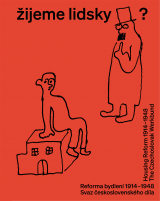Žijeme lidsky?
Reforma bydlení 1914–1948. Svaz československého díla / Housing Reform 1914–1948. The Czechoslovak Werkbund

| Autor: |
Iva Knobloch
|
| Jazyk: |
anglicky, česky |
| Vazba: |
pevná |
| Počet stran: |
652 |
| Formát: |
22 x 28 cm |
| ISBN/EAN: |
9788027609666 |
| Nakladatel: |
Slovart |
| Rok vydání: |
2024 |
| Edice: |
české umění
/ Umění
|
Souhrnná publikace vůbec poprvé představuje Svaz československého díla v průběhu třiceti let jeho existence. Svaz výrazně modernizoval nejen oblast bydlení a architektury, ale také užitkových předmětů, hraček, grafického a výstavního designu. Jeho členy byli pokrokoví představitelé architektury a designu meziválečného Československa, jako jsou Pavel Janák, Ladislav Sutnar, Ľudovít Fulla a další. Mezi jejich nejvýznamnější počiny patří výstavba prvních československých funkcionalistických osad v Brně (Nový dům, 1928) a v Praze (Baba, 1932), a zejména pak Dům uměleckého průmyslu v centru Prahy. Publikace seznamuje s projekty formou textů renomovaných českých a slovenských autorů společně s bohatou obrazovou přílohou vynikajících dobových fotografií od Josefa Sudka, Jaromíra Funkeho, Františka Illka, Alexandra Paula a dalších. This comprehensive publication presents for the first time ever the Czechoslovak Werkbund during the thirty years of its existence when it significantly modernized not only the field of housing and architecture, but also utilitarian objects, toys, and graphic and exhibition design. Its members were progressive representatives of architecture and design in interwar Czechoslovakia, such as Pavel Janák, Ladislav Sutnar and Hana Kučerová-Záveská. The Werkbund's most important activities were the construction of the first Czechoslovak functionalist housing estates in Brno (Nový dům, 1928) and Prague (Baba, 1932), and the House of Art Industry in the centre of Prague. This publication introduces the projects through renowned Czech and Slovak authors, and illustrates them with superb period photographs by Josef Sudek, Jaromír Funke, František Illek and Alexandr Paul, among others.
            
Diskuze
Žádný příspěvek do diskuze. Přidejte svůj názor »
|





















